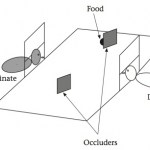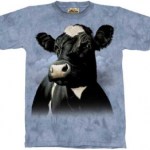wolf
Check out this video from Scientific American discussing how canids from different areas have different 'dialects':
Image of Canis lupus by Gary Kramer, from US Fish & Wildlife Service.
Researchers have designed a computer program that can identify an individual wolf in the wild analyzing the frequency and amplitude of their howls. They were able to accurately identify an individual Eastern grey wolf (Canis lupus lycaon) with 97% accuracy using the program. This program is expected to be highly useful to wolf biologists and conservationists.
This program would certainly make camping more entertaining as well.
Source:
Root-Gutteridge H, Bencsik M, Chebli M, Gentle LK, Terrell-Nield C, Bourit A,…
You've probably had a conversation that goes something like this:
Person A: "My dog is sooooo amazing!"
You: "I mean, dogs are awesome and all, but what's so amazing about this particular dog?"
Person A: "He just understands me. It's like he knows what I'm thinking and what I need."
You: "Do you think he's just maybe responding contingently do your overt displays of emotion?"
Person A: "Listen, man, I'm telling you: my dog can read my mind!"
No matter on which side of this sort of argument you tend to fall, the question of whether or not domestic dogs can read human minds is an interesting…
Via the Smithsonian Channel:
Gudrun Pflueger, first seen in A Woman Among Wolves, returns to wolf country after a grueling and terrifying bout with cancer.
Determined to fight for the wolves who gave her the strength to survive her illness, Pflueger battles freezing temperatures and personal setbacks to track the wolves in the wild. The data she collects in the wolves' dwindling habitat may one day help stave off extinction of this keystone species. Witness the dramatic story of survival and endurance that culminates in nothing less than a scientific miracle.
Throughout the month of March…
Eric M. Johnson and I spent about 45 minutes discussing "evolutionary psychology beyond sex" last night, which you can see today on Bloggingheads "Science Saturday."
Or just watch it here:
I showed this video today as an intro to my 8-week "mini-course" on Canine Cognition.
In it, narrator John Lithgow presents two slightly different versions of the dog domestication story. The first version is essentially the Belyaev story: young wolves would be adopted into the camps of early humans. Only those who were most tame would breed with eachother, and over many generations, the domestic dog would emerge. The second is the version in which wolves "chose" to be domesticated - they noticed a lot of tasty trash around human encampments, and if they were unafraid enough to hang around,…
Dogs are pretty smart. They can have huge vocabularies, they can infer meaning in the growls of other dogs, and they can effortlessly figure out if other dogs want to play or fight with them. But their intelligence might be limited to the social domain; indeed, while they outperform chimpanzees in social tasks, chimpanzees outperform them in many other tasks. And they might have developed their impressive social skills as merely an accident of natural and artificial selection.
Previous research has shown that dogs can use lots of different forms of human communicative signals to find food,…
A drop in the bucket - a massive pile of bison skulls about to be ground into fertilizer, photographed circa 1870. From Wikipedia.From almost the very start, wolves were not welcome in Yellowstone. When the national park was established by the United States government in 1872 the bison population had crashed - a victim of westward expansion, the fur trade, and the desire to deprive native people of an animal important to their existence - leaving the area's wolves little recourse but to begin preying upon local livestock. This did nothing to help their reputation. Already seen as nature's…
Let me tell you a little story. When I was born my parents had two cats. One was named Garfield. The other...well, I don't remember what the other one was called. Not long after I was born, and little Jason was coughing up furballs, the doctors informed the parents that their little bundle of skin and hair was allergic to cats. It was then that teams were picked and lines were drawn. It was me or the cats. Luckily, the parents decided to keep me, and lose the cats. Imagine how much it would have sucked if they decided to keep the cats and lose me. I imagine if my younger brother had actually…
An African wild dog (Lycaon pictus, left) compared to a spotted hyena (Crocuta crocuta, right). Both photographed at the Bronx Zoo.
It never fails. Whenever I visit a zoo's African wild dog exhibit someone inevitably asks "Are those hyenas?", and when I visit spotted hyena enclosures I often hear the question "Are those dogs?" These carnivores, known to scientists as Lycaon pictus and Crocuta crocuta (respectively), are only distant cousins, but the vague similarities shared between them often cause people to confuse one with the other.
There are a few quick and dirty ways to tell them apart…
The party continues! Today you get a double-dose of Monday Pets. Here's one from the archives. Later today, you can expect a new one.
I often write about animals that the average person does not interact with all that much on a day-to-day basis. Today, I introduce something I like to call "Monday Pets". The focus of Monday Pets will be the animals that we intentionally bring into our lives as pets. Sometimes those animals are even considered part of the family. Ever notice some weird behavior that you notice your pets doing? Want to know more about it? Email me. Always wanted to know if your…
This article pointed me to this interesting paper, Rapid adaptive evolution of northeastern coyotes via hybridization with wolves:
The dramatic expansion of the geographical range of coyotes over the last 90 years is partly explained by changes to the landscape and local extinctions of wolves, but hybridization may also have facilitated their movement. We present mtDNA sequence data from 686 eastern coyotes and measurements of 196 skulls related to their two-front colonization pattern. We find evidence for hybridization with Great Lakes wolves only along the northern front, which is…
Straight from Katie and Andrew's closets we bring you this Mountain Dew-soaked photographic essay.
An explosive herbivore bursts forth from your chest
So many, many more below the fold...
Oh my sternum? Yes, it's real bear
Spirit of the Casino
A rare candid glimpse into pre-Columbian North America
We count four offensive things in this shirt. How many can you find?
Seizure inducing dolphins
T-Rexes fight on the moon
In the June Atlantic Monthly, Joshua Wolf Shenk has a long, moving article about what may be the longitudinal study of all longitudinal studies - the Harvard Study of Adult Development (Grant Study), begun in 1937. Its creator Arlie Beck planned to track 268 "healthy, well-adjusted" men from their sophomore year at Harvard through careers, marriage, families, retirement and eventually death - and somehow, from this glut of longitudinal data, to glean the secrets of "successful living."
But the portrait Shenk paints is as full of pathos as it is of success.
Delving into the case files, now…
Being confronted with a pack of wolves is bad enough, but if you happened to be in Alaska some 12,000 years ago, things would be much, much worse. Back then, the icy forests were patrolled by a sort of super-wolf. Larger and stronger than the modern gray wolf, this beast had bigger teeth and more powerful jaws, built to kill very large prey.
This uber-wolf was discovered by Jennifer Leonard and colleagues from the University of California, Los Angeles. The group were studying the remains of ancient gray wolves, frozen in permafrost in eastern Beringia, a region that includes Alaska and…
Wolves are among my favorite carnivores, but they're often shy even in zoo settings, making them difficult to photograph. During my visit to the National Zoo this past spring, however, this Mexican Wolf (Canis lupus baileyi) came down to get a drink from the pool at the edge of the enclosure, allowing me to snap a few photos. Not everyone likes wolves as much as I do, though, and the Mexican Wolf is currently critically endangered with only about 200 individuals left in the wild. As with other wolves, this subspecies (ranging from Mexico across the southwestern U.S. and as far north as…





